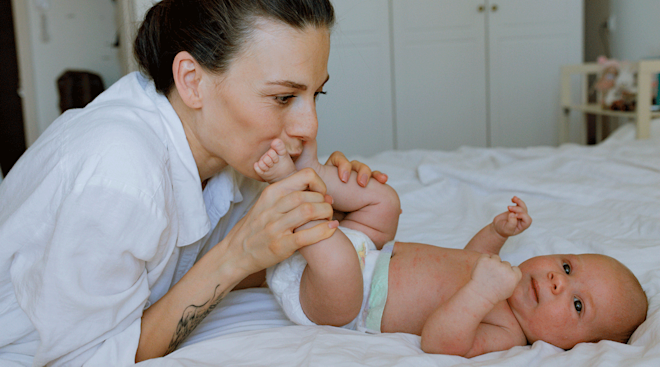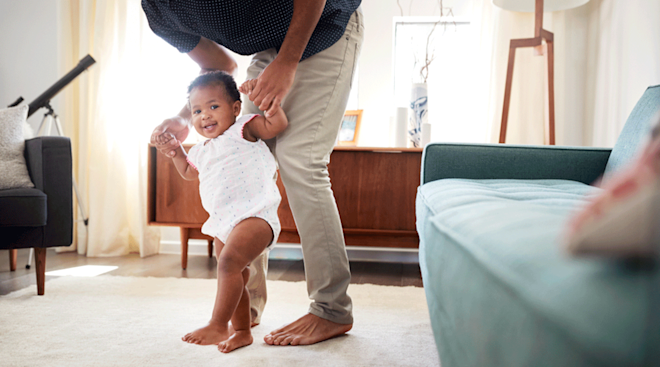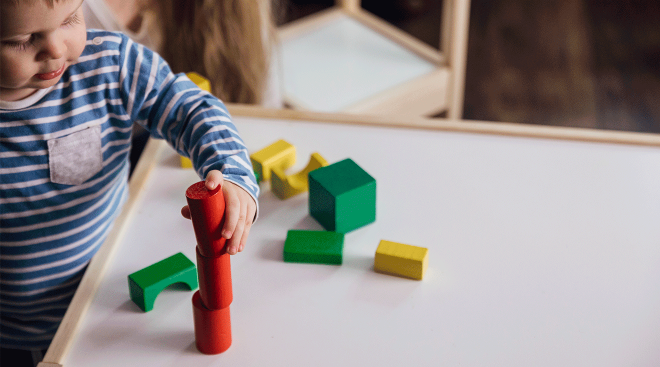Introducing Tummy Time to Baby
With all the focus on putting baby to sleep on their back, it’s easy to forget that tummy time is actually pretty important. Though it’s tough to see at first, all those little wiggles and attempts at half-lifts are contributing to baby’s development in major ways, preventing flat spots from forming on the back of their head (a side effect of all that time on their back) and preparing them for a few down-the-road milestones like rolling over and crawling. But if you’re new to this whole parenting gig, you might be wondering what exactly tummy time is and how it works. Don’t worry, we’re here to help with answers to all the questions you didn’t even know you had. So at what age should you start tummy time? And how often does baby need to do it? Read on to learn everything you need to know about the important developmental exercise known as tummy time.
When we talk about tummy time, what exactly do we mean? Suffice to say, tummy time is exactly what it sounds like—time that baby spends on their stomach while awake and supervised. Placing baby on their tummy encourages them to lift their head, which helps strengthen their head, neck and shoulder muscles and boost motor skills.
We know, it’s not easy to make baby do an activity they’re less than thrilled about. But trust us, tummy time is worth it. In addition to offering a sweet way for the two of you to bond, there are some major benefits of tummy time:
- Practice for milestones like rolling over, sitting upright and crawling
- Strengthens gross motor skills
- Engages lesser-used muscle groups
- Prevents plagiocephaly (aka flat head syndrome)
- Helps baby master head control
- Alleviates gas pain
- Exposes baby to a different environment
At what age should you start tummy time? While there’s no prescription for exactly when to begin practicing tummy time, the American Academy of Pediatrics recommends parents get going on it early. In fact, babies born at full term with no health issues can start tummy time as soon as their first day home from the hospital—so long as you and your newborn are both awake and alert, and you or another caregiver are there to supervise.
Don’t be surprised if baby hates tummy time and those initial attempts are met with some resistance. “Babies usually don’t like it and get cranky about it,” says Michael McKenna, MD, a pediatrician at St. Vincent Medical Group in Zionsville, Indiana. “The first time, they might only be down there for a minute before they start screaming. It’s about getting them used to being in that position. You’ll probably have to start with short sessions and work your way up.”
Now that you know when to start tummy time (the sooner, the better!), you may be wondering how long each practice session should last. A little bit of tummy time actually goes a long way. When it comes to newborn tummy time, aim for two to three sessions a day for three to five minutes at a time, ideally after a nap or diaper change and as part of playtime. “You can stop or take breaks in there if your baby is having a tough time,” says Ashanti Woods, MD, a pediatrician at Mercy Family Care Physicians in Baltimore, Maryland.
As baby gets older and begins to enjoy this “workout,” gradually ramp up the number and duration of tummy time sessions. Aim for around 20 to 30 minutes a day of baby tummy time by the time they’re 3 or 4 months old. Remember, it doesn’t have to happen in one long session. Keep the practice up until baby can roll over on their own, a feat many babies accomplish around 4 to 6 months of age. Even then, you may consider keeping tummy time practice a part of your regular routine; it’ll help them as they start learning to crawl.
Like most exercises, tummy time is pretty straightforward. Here’s how to get started:
- Set-up a soft, safe space and lay baby down. A blanket or a tummy time mat on a firm, flat surface works well. The floor is an ideal spot, though you can also lay your infant tummy down on your stomach or chest or across your lap.
- If baby doesn’t respond to tummy time on their own, try to engage them. Seeing your face can be incentive enough for baby to try lifting their head from your body, but McKenna warns that sometimes this plan can backfire. A sleep-deprived new parent (read: all of us!) might be tempted to snooze. Or, if you manage to stay awake, baby might not have incentive to lift their head off of your warm body and they could drift off to sleep.
See how it goes and how baby responds to tummy time. You may need to play around with positioning. If, say, baby really can’t handle being on their stomach, consider laying them on their side. This AAP-recommended position has baby on a blanket, laying on their side, with a rolled-up towel behind their back and a rolled-up washcloth under their head for support (if needed). Bring both of baby’s arms in front of them and both legs forward, bending their knees for comfort. Be sure to roll them to the alternating side every 10 to 15 minutes. (Of course, this activity shouldn’t entirely replace tummy time, so keep trying!)
In a perfect world, your infant will push up and move around on their own during tummy time. But chances are, they’ll need some sort of stimulation to stay engaged. Here are some tummy time moves and distraction to try:
-
Use special tummy time toys. Pull out one or two novel tummy time toys and place them just out of reach, so baby has to extend themselves to grab them. You can also try holding a brightly colored stuffed animal or shaking a rattle near baby’s face to distract them from the task at hand.
-
Use a mirror. Do you have an unbreakable baby mirror from a playmat or toy? Put this in front of baby’s face. They may enjoy seeing their reflection during tummy time.
-
Get in on the tummy time action. If your little one isn’t happy about exercising alone, you can join the activity. “Lay down there with your baby,” McKenna suggests. “Move their hands around, have them feel new things, read to them or put down different-colored blankets—something to keep it interesting for baby.” You can also enlist a sibling to help entertain baby.
-
Use your body. Tummy time on the floor might not be your baby’s thing for a while. If this is the case, you can use your own body as baby’s personal tummy time mat. Place baby across your lap, belly down. Use your hand to rub their back or offer gentle, rhythmic pats. You can also try laying down on your back and placing baby tummy down on your belly.
-
Try a football hold. Hold baby like a football, balancing their tummy on your arm with their legs and arms on either side. Be sure to support their back and neck with your other hand. This is a good beginner option for babies who resist any and all tummy time.
-
Prop baby up. If baby doesn’t like being flat on their tummy, you can try propping them with a nursing pillow under their chest at first. This will hopefully get them used to the position, so that you can eventually (and gradually) remove any props. With or without a pillow, remember to always keep an eye on baby while they’re practicing tummy time.
What if baby still hates tummy time? Don’t stress—and don’t give up, Woods advises. “Like many things with children, it’s okay to step back, take a break and come back to tummy time,” he says. “Take a couple of days or a week off, and try again later. You’ll likely see success after you take a breather.” Also consider shortening sessions and spacing tummy time out throughout the day to make the task a little more bearable for baby. A little here and there all add up. “As long as they are doing some [tummy time], it will have some benefit,” McKenna points out.
Incorporating tummy time into your daily routine with baby might feel daunting at first—especially if they fight the activity. Don’t put too much pressure on yourself or your little one right away. Gradually, they’ll get used to this position, and you’ll find a few creative ways to squeeze in some practice.
Please note: The Bump and the materials and information it contains are not intended to, and do not constitute, medical or other health advice or diagnosis and should not be used as such. You should always consult with a qualified physician or health professional about your specific circumstances.
Plus, more from The Bump:
Michael McKenna, MD, a pediatrician at Ascension Medical Group in Zionsville, Indiana. He earned his medical degree at Indiana University School Of Medicine in St., Indianapolis.
Ashanti Woods, MD, a pediatrician at Mercy Family Care Physicians in Baltimore, Maryland. He earned his medical degree from Howard University College of Medicine in Washington, DC.
American Academy of Pediatrics (AAP), Back to Sleep, Tummy to Play, August 2023
American Academy of Pediatrics (AAP), 3 Tummy Time Activities to Try With Your Baby, July 2023
Learn how we ensure the accuracy of our content through our editorial and medical review process.
Navigate forward to interact with the calendar and select a date. Press the question mark key to get the keyboard shortcuts for changing dates.




















































